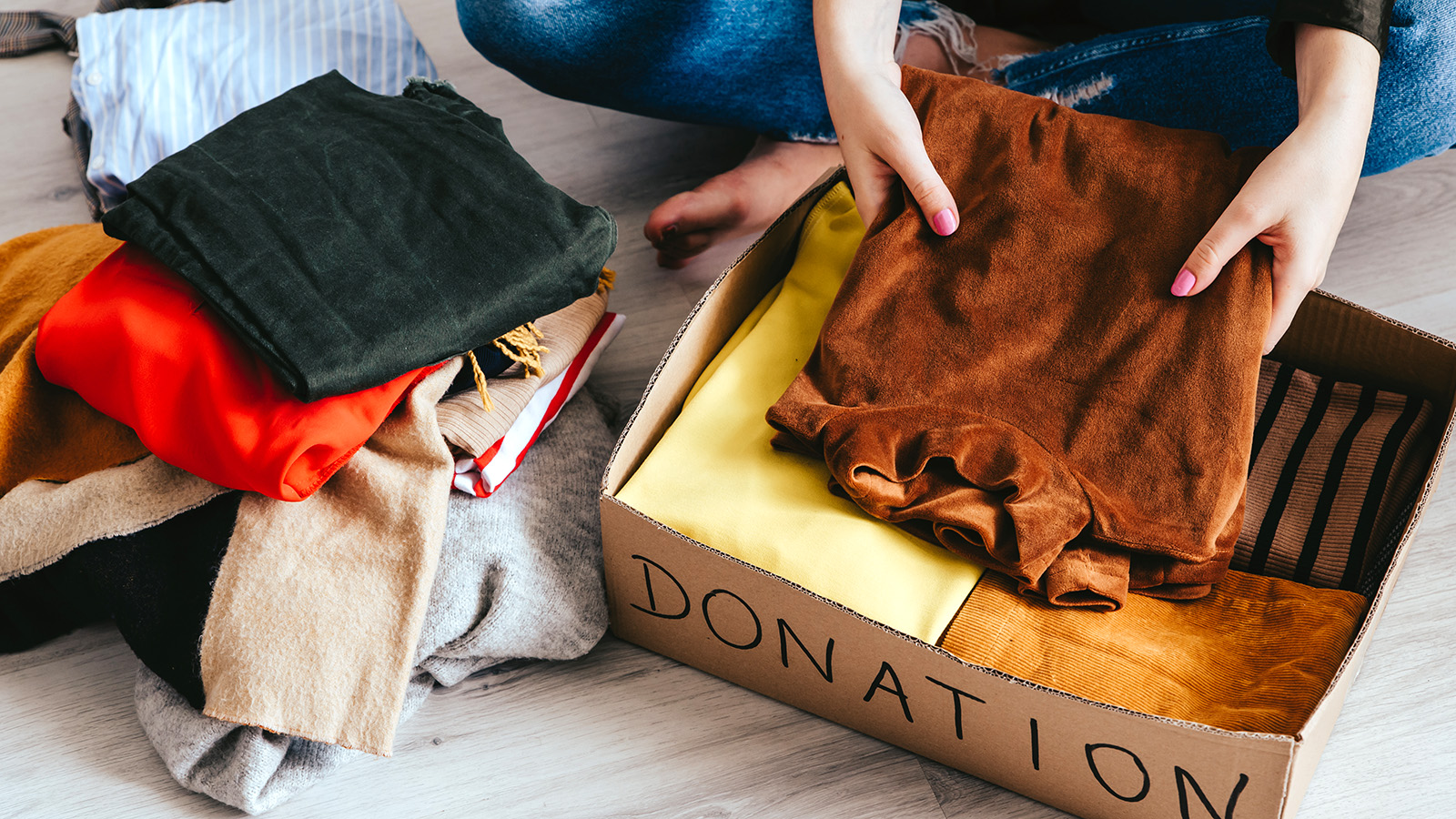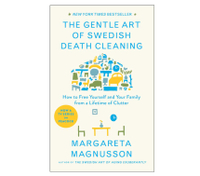I tried the Swedish death cleaning trend for a week — and it changed everything
My house will never be the same again

None of us like to think about our own mortality, but according to experts, considering your lifestyle with the end in mind is a good way of thinking about the things that really matter in line, and this applies to your clutter, too.
Put simply, the Swedish death cleaning method requires you to tidy your home and belongings with the mindset that if you were to die tomorrow, you wouldn’t want to leave it behind for a loved one to tidy for you. It's easy to accept conditions in your life that you wouldn't want to subject a loved one to, so this change in mindset is a good way to prioritize your own wellbeing when decluttering your home.
It’s become ever more trendy since Margareta Magnusson coined the term in her 2017 book, The Gentle Art of Swedish Death Cleaning: How to Free Yourself and Your Family from a Lifetime of Clutter. And even more so since the release of Peacock’s show, of the same name, produced by Amy Poehler.
What is Swedish death cleaning?

Swedish death cleaning is a well-known Swedish phenomenon, referred to as döstädning, in which you sort and declutter your belongings with your own passing in mind. If you get rid of the clutter and mess now, you’re saving the loved ones you leave behind a lot of hassle when you pass. A morose concept, but one that has proven a trendsetter as an effective way to clean and a clear way to avoid 5 decluttering mistakes. However, if this is all a bit much, you could try a simpler method to get your started, such as the 2-minute decluttering hack.
As mentioned, Margareta Magnusson’s book revolutionized the term and guides readers through the method. She encourages anyone 65 and over to take part in death cleaning, but her method has proven incredibly handy for those younger too. After all, there are probably at least 9 things you’re hoarding, which you should throw away right now. I’m 32, and it certainly wouldn’t hurt to tidy up the stuff I’ve been accumulating all these years. Even if I risk having an existential crisis in the process…
Margareta Magnusson's book is designed to make the process of decluttering uplifting, and contextualize your accumulation of items throughout your life.
I tried Swedish death cleaning — here’s what happened
Margareta says the best way to approach Swedish death cleaning is to start with areas that are easy to tackle, like your loft space or basement. With a loft full of forgotten objects, I did initially agree with this part of the process so headed up into my loft to stare at things I didn’t even realize I had anymore. It felt easier to deal with until I started disturbing the dusty peace. Why does it feel like you have exponentially more stuff as soon as you start to move it around? After the initial overwhelming nature of the task ahead, I broke it down into what I would donate, keep, or throw and it became clearer.
I quickly noticed though that perhaps I’d been practicing döstädning all my life. At different points in time, I’ve become overwhelmed by belongings and deemed many unnecessary - donating, selling, or throwing away as necessary to rid myself of the heaviness of belongings. But, as I’ve gotten older and had children, it’s become increasingly difficult to determine how I feel about objects. Swedish death cleaning let me reframe.
Day One: The Loft
So, on day one, I targeted the loft. Old, dusty shoes and musical instruments I once knew how to play. The shoes were easy enough. Hoover them off and sell them, donate them, bin any with irreparable damage. Musical instruments panged sentimentality. My grandad bought me those.I felt like leaving those for someone else to deal with after me would remove my level of connection. They wouldn’t know the sentimental nature and someone else could disregard them as old instruments they could sell on and then they’d be gone. That felt simpler.
It then struck me that I should have a conversation with my partner about what I’d like to keep and pass on. I don’t hold many things in my possession that I find sentimental. I wouldn’t mind if he sold the instruments, but I didn’t want to do it. But then, was I leaving a job for him that I didn’t want to deal with myself?
Day Two: Room-by-room

On day two, I practiced another of Margareta’s recommendations. Do your Swedish death cleaning room by room, if the idea of taking on your entire house feels overwhelming. So, I headed for the wardrobe as she also suggests clothes are easier to sort. The beauty of donating and selling your garments instantly feels like it’s not such a waste. Someone else will wear it… but then I might miss it. The best way I dealt with this part of the death cleaning was to not give it too much thought. Unlike all the other pondering I’d been doing, clothes felt like something I should just sort and forget about. Bag up for charity and send it away to a new home.
Day Three: The Wardrobe
Day three, the wardrobe was half on the floor still and I’d shoved it to the side of the room to get to bed and shuddered at the thought of continuing to deal with it. Alas, I carried on and made a pretty good dent in it. It became clear to me that Swedish death cleaning would change my state of mind, but it wouldn’t so immediately change my home. This was a long job.
For a few more days, I worked my way through the wardrobe and eventually moved onto the boxes under the bed. I began to feel like Swedish death cleaning was confusing me. Yes, I needed to rid myself of things that my loved ones wouldn’t have to deal with. But no, I’m not actually gone yet and I might need these things should I ‘last’ another few decades? Hopefully…
Does it work?

It’s a really strange feeling staring at all the belongings you’ve accumulated over your life and suddenly forcing yourself to contemplate their necessity if you were to die tomorrow. For me, everything suddenly warped into mediocrity. I wasn’t finding this trend easy, but it felt like something I would persevere and take into my life moving forward. Beyond the week of death cleaning, the trend also suggests that you cut back on purchases and honestly, this was the biggest difference for me.
I believe I’ll go into future purchases thinking about how necessary these items would be and how I’d then become responsible for them forever, or until I passed them on to someone else. You won’t have as much as stuff, if you just buy less. I’ll struggle to tidy up my entire home because some items feel necessary right now, even if they won’t in the future. But, it’s made me more mindful and whenever I do decide it’s time to tackle the big clean again, I can’t imagine a time where I’ll tidy and not stare my very own existence in the face as I do it.
More from Tom's Guide
Sign up to get the BEST of Tom's Guide direct to your inbox.
Get instant access to breaking news, the hottest reviews, great deals and helpful tips.
Grace is a freelance journalist working across homes, lifestyle, gaming and entertainment. You'll find her writing for Tom's Guide, TechRadar, Space.com, and other sites. If she's not rearranging her furniture, decluttering her home, or relaxing in front of the latest streaming series, she'll be typing fervently about any of her much-loved hobbies and interests. To aid her writing, she loves to head down internet rabbit holes for an unprecedented amount of time.
-
John Pombrio I have an elderly friend that has no living relatives nearby, so will probably leave his house and contents to charity. I have tried to get him to remove the massive amounts of stuff in the house and the basement. Sadly, he is one of those "someone would like this!" or "I might use that again someday!" This is the bane of trying to get anyone to declutter. A couple of large dumpsters would be needed when he dies.Reply


